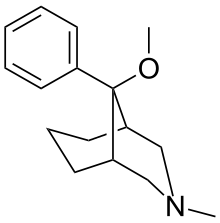Anazocine
Anazocine (INN; also known as azabicyclane or CS-307) is an opioid analgesic of the morphan/benzomorphan family developed in the middle 1960s in the United States which was never marketed.[1][2] It is listed by some sources as a teratogen.[3]
 | |
| Clinical data | |
|---|---|
| ATC code |
|
| Identifiers | |
IUPAC name
| |
| CAS Number |
|
| PubChem CID | |
| ChemSpider | |
| ChEMBL | |
| Chemical and physical data | |
| Formula | C16H23NO |
| Molar mass | 245.366 g·mol−1 |
| 3D model (JSmol) | |
SMILES
| |
InChI
| |
The structure and properties of several related α- and β-azabicyclane opioids was explored.[4] Anazocine's chemical and structural relatives include opioid partial agonists, mixed agonist-antagonists, pure agonists, antagonists, and atypical non-opioid analgesics. It was tested in pigeons and in other experiments which contrasted and compared its analgesic effects to those of the phenazepine opioid ethoheptazine and the phenalkoxam open chain opioid propoxyphene,[5] and pethidine as well.[6]
See also
- Benzomorphan
References
- F.. Macdonald (1997). Dictionary of Pharmacological Agents. CRC Press. p. 146. ISBN 978-0-412-46630-4. Retrieved 22 April 2012.
- Kobayashi S, Hasegawa K, Oshima T, Takagi H (September 1970). "The pharmacology of azabicyclane, a new analgesic agent". Toxicology and Applied Pharmacology. 17 (2): 344–54. doi:10.1016/0041-008X(70)90191-2. PMID 5528556.
- "Archived copy". Archived from the original on 2016-02-15. Retrieved 2016-03-01.CS1 maint: archived copy as title (link)
- Froimowitz, Mark; Salva, P; Hite, G. J; Gianutsos, G; Suzdak, P; Heyman, R (1984). "Conformational properties of α- and β-azabicyclane opiates. The effect of conformation on pharmacological activity". Journal of Computational Chemistry. 5 (4): 291–298. doi:10.1002/jcc.540050403.
- Kobayashi S, Hasegawa K, Oshima T, Takagi H (September 1970). "The pharmacology of azabicyclane, a new analgesic agent". Toxicol. Appl. Pharmacol. 17 (2): 344–54. doi:10.1016/0041-008X(70)90191-2. PMID 5528556.
- Leander, J. David (1979). "Effects of propoxyphene, ethoheptazine, and azabicyclane on schedule-controlled responding: Attenuation by pentobarbital but not naloxone". Psychopharmacology. 66 (1): 19–22. doi:10.1007/BF00431983. PMID 44372.
This article is issued from
Wikipedia.
The text is licensed under Creative
Commons - Attribution - Sharealike.
Additional terms may apply for the media files.